 "ttyymmnn" (ttyymmnn)
"ttyymmnn" (ttyymmnn)
07/20/2018 at 12:35 • Filed to: wingspan, Planelopnik, TDIAH
 15
15
 0
0
 "ttyymmnn" (ttyymmnn)
"ttyymmnn" (ttyymmnn)
07/20/2018 at 12:35 • Filed to: wingspan, Planelopnik, TDIAH |  15 15
|  0 0 |
!!! UNKNOWN CONTENT TYPE !!!
Welcome to
This Date in Aviation History
, getting of you caught up on milestones, important historical events and people in aviation from July 18 through July 20.
!!! UNKNOWN CONTENT TYPE !!!
July 19, 1989 – United Airlines Flight 232 suffers complete hydraulic failure over Iowa following an uncontained engine failure. Statistically, commercial aviation is one of the safest forms of transportation in the world. Considering the number of flights every day the world over, and the number of passengers carried, fatal accidents are exceedingly rare, a safety record made possible by rigorous maintenance and highly trained crews. But aircraft crews operate best when they work together, and one of the most important advances in aviation safety came with the adoption of !!!error: Indecipherable SUB-paragraph formatting!!! (CRM) which arose out of two significant accidents: The !!!error: Indecipherable SUB-paragraph formatting!!! in 1977, and the crash of !!!error: Indecipherable SUB-paragraph formatting!!! in 1978. In the first, two fully-loaded !!!error: Indecipherable SUB-paragraph formatting!!! collided on a foggy runway when the captain of one airliner refused to listen to the tower or his co-pilot, and in the second, the cockpit crew became so engrossed with solving a problem with the landing gear that they failed to monitor their fuel levels. The plane simply ran out of fuel and crashed in the Florida Everglades. Had both these crews been able to work together more effectively, delegating tasks, focusing on communication, and simply flying the plane, the crashes may not have happened.
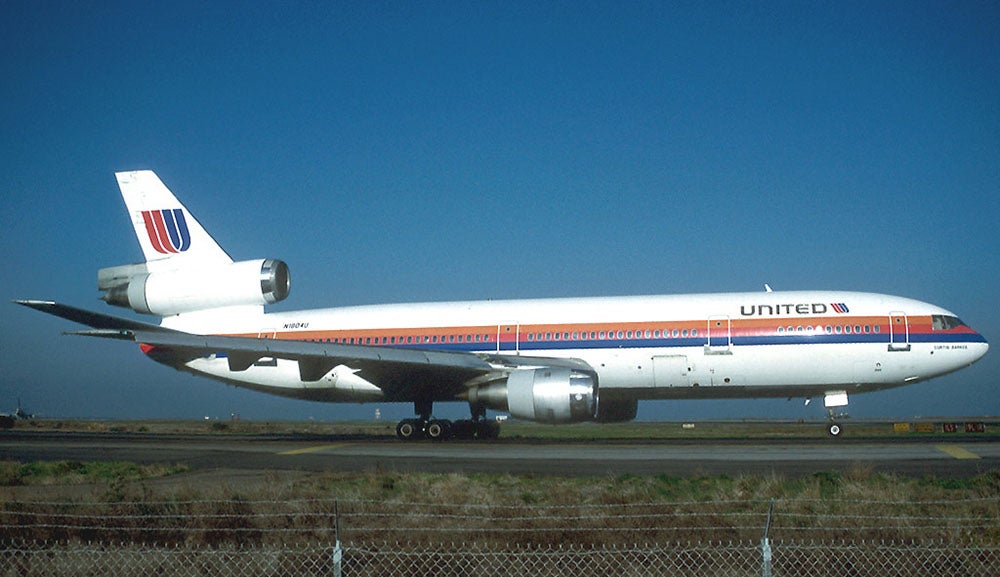 !!!CAPTION ERROR: MAY BE MULTI-LINE OR CONTAIN LINK!!!
!!!CAPTION ERROR: MAY BE MULTI-LINE OR CONTAIN LINK!!!
United Airlines was the first major airline to institute CRM in 1981, and it paid off brilliantly just eight years later at Sioux City, Iowa. !!!error: Indecipherable SUB-paragraph formatting!!! was a regularly scheduled flight of a !!!error: Indecipherable SUB-paragraph formatting!!! (N1819U) from Denver International Airport to Chicago O’Hare. The sequence of events leading to the crash landing in Iowa began as the airliner was cruising at 37,000 feet when the fan disk on the tail-mounted !!!error: Indecipherable SUB-paragraph formatting!!! turbofan engine failed. Pieces of the broken disk ruptured all three hydraulic lines on the DC-10, leaving the aircraft practically uncontrollable. As Captain !!!error: Indecipherable SUB-paragraph formatting!!! and first officer William Records stuggled to control the aircraft, they were joined in the cockpit by Training Check Airman Captain !!!error: Indecipherable SUB-paragraph formatting!!! , a passenger on the flight. The crew discovered that they could gain a measure of control over the plane by steering using alternating thrust of the two operable wing engines, and they could change altitude by adjusting the thrust of both engines together. Working as a team, Haynes and Records focused on trying to fly the plane and communicate with air traffic controllers, while Fitch worked the throttles. After considering their options, they decided to attempt an emergency landing at Sioux City, Iowa.
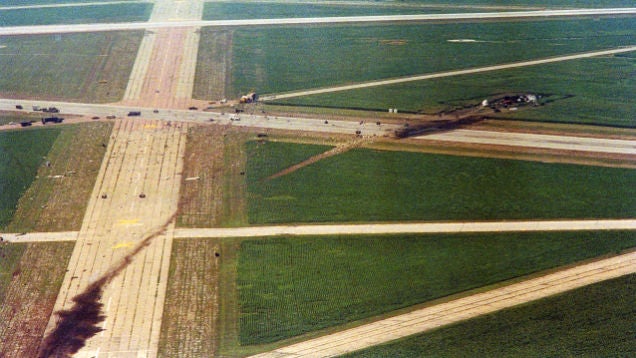
An aerial photo of the crash landing site. (AP)
Without control of the flaps and slats, the pilots were unable to slow their rate of descent, nor could they !!!error: Indecipherable SUB-paragraph formatting!!! the airliner for landing or slow it down to a safe landing speed. As the DC-10 descend toward Sioux City, the airliner was going 252 mph and dropping at 1,850 feet per minute instead of the prescribed 161 mph and 300 feet per minute. The DC-10 struck the runway hard and fast, but only slightly off center. The airliner cartwheeled down the runway, with portions of the fuselage ending up in a nearby cornfield. Despite the crash landing and fire, 185 of the 296 passengers and crew survived. The flight deck crew, badly injured yet still alive, was heralded as heroes, and their teamwork was held up as a shining example of CRM. The failure of the fan disk was found to have been caused by improper manufacturing processes and a failure to identify cracks in the blades during routine maintenance. As a result, maintenance and manufacturing procedures were changed to prevent future accidents, and changes to the hydraulic system were implemented to ensure that complete loss of hydraulic pressure would not happen in the future.
!!! UNKNOWN CONTENT TYPE !!!
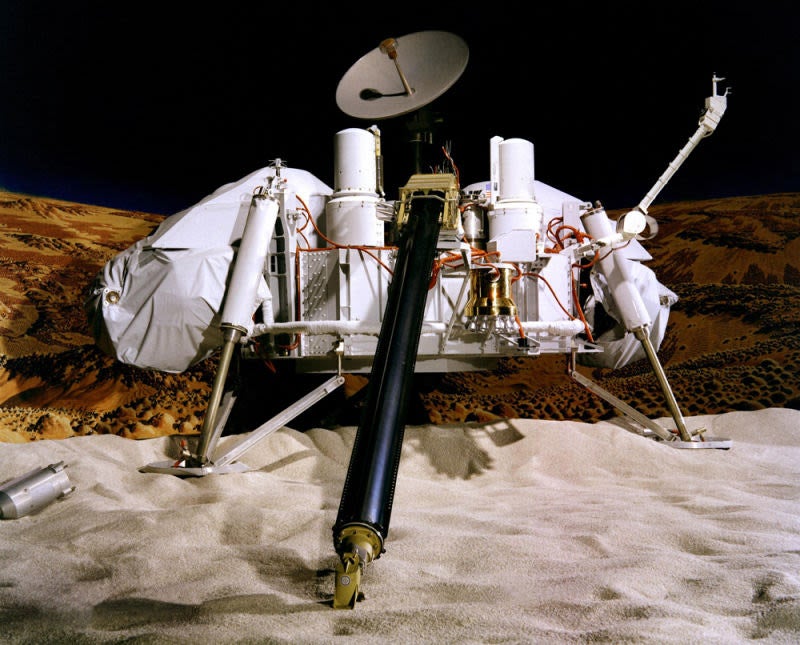
(NASA)
July 20, 1976 – Viking 1 lands on Mars. By the late 1800s, theories about Mars, particularly whether or not there was life on the Red Planet, were at a fever pitch. Astronomers made detailed maps of the planet based on their observations through telescopes, and some determined that the features they were seeing on the planet’s surface were undoubtedly canals built for transportation by Martian inhabitants. !!!error: Indecipherable SUB-paragraph formatting!!! wrote one of the great seminal works of science fiction when he published The War of the Worlds in 1898, chronicling the harrowing tale of a Martian invasion of Earth. But looking at a distant world through a telescope only gave scientists so much information. Ultimately, there is no substitution for actually going to the planet and making firsthand scientific observations.
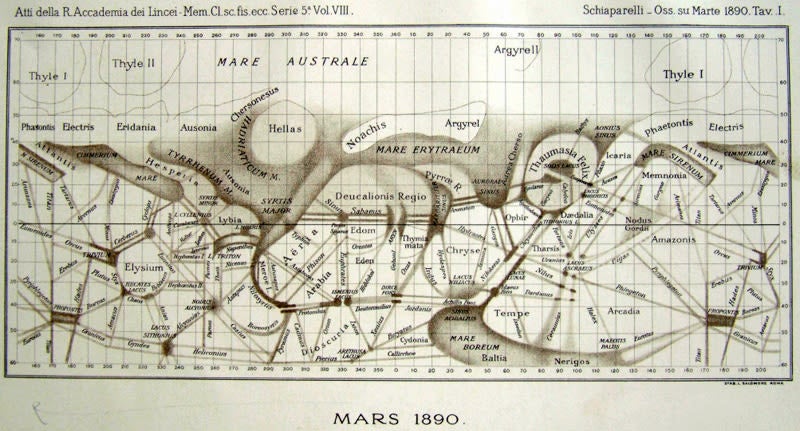
An early map of Mars based on telescope observations.
Spurred on by the !!!error: Indecipherable SUB-paragraph formatting!!! , the Soviets launched the first of a series of probes to Mars in 1960, though it was not until 1965 that NASA’s !!!error: Indecipherable SUB-paragraph formatting!!! performed the first successful fly-by of the planet. Six years later, !!!error: Indecipherable SUB-paragraph formatting!!! became the first space probe to orbit another planet when it circled Mars and returned the first photographs of the Martian surface. The Russians were the first to put a spacecraft on the planet, but problems with the landers meant that no useful data was returned. NASA’s efforts to put a lander on Mars began with the !!!error: Indecipherable SUB-paragraph formatting!!! , which planned to use rockets and landers based on those used in the !!!error: Indecipherable SUB-paragraph formatting!!! . Though that initiative was canceled in 1968, the impetus to go to Mars remained, and the project became known as Viking, a much less complex—and less expensive—alternative.
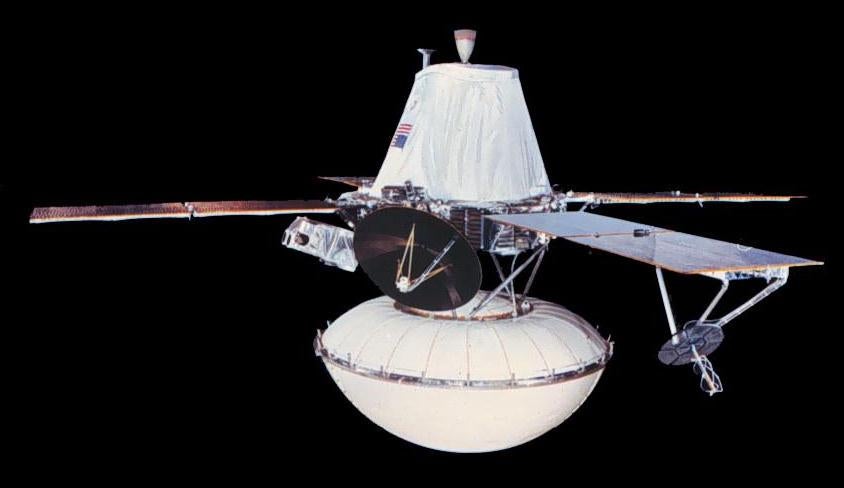
The Viking spacecraft. The top section, with solar panels and rocket motor, is the Orbiter. The lower bulbous section housed the Lander. (NASA)
For Viking, NASA launched two probes, Viking 1 and Viking 2. Each spacecraft was composed an Orbiter and a Lander. Not only was the Orbiter designed to carry the Lander, but it also had its own important functions in the mission. It made scientific observations of the Martian surface with its cameras, looked for water vapor with its infrared spectrometer, and created a thermal map of the surface with its infrared radiometer. The Orbiter also served as a communication relay between the Lander and Earth. The Lander was a three-legged assemblage of cameras and instruments that descended penetrated the Martian atmosphere protected by a heat shield, and was then slowed by parachutes before touching down on the planet surface. Viking 1 was launched from Cape Canaveral, Florida on August 20, 1975 atop a !!!error: Indecipherable SUB-paragraph formatting!!! rocket and, after a 10-month journey, began orbiting Mars on June 19, 1976. Viking 1's sister ship, Viking 2, launched a month later. After Viking 1 reached Mars, it spent its first month in orbit making observations and selecting a safe spot for the Lander to touch down. Then, on July 20, the Lander separated from the Orbiter and touched down on a smooth Martian plain known as !!!error: Indecipherable SUB-paragraph formatting!!! (Golden Plain).
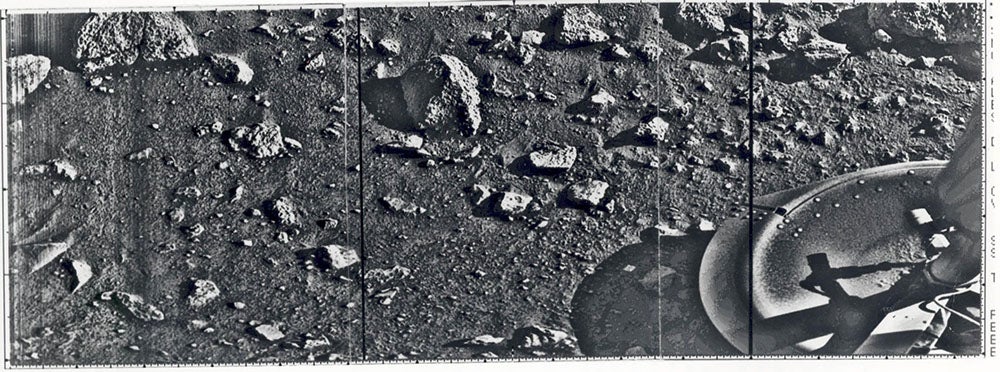 !!!CAPTION ERROR: MAY BE MULTI-LINE OR CONTAIN LINK!!!
!!!CAPTION ERROR: MAY BE MULTI-LINE OR CONTAIN LINK!!!
Viking 1 didn’t find any signs of technologically advanced cultures planning to invade the Earth, nor any signs of life at all. However, the first clear photos ever taken from the Martian surface showed geological forms such as valleys and erosional features on volcanoes that indicated the presence of large amounts of water at one time in Mars’ history. This discovery fundamentally changed scientists’ theories about the history of Mars, and influenced future missions in the search for water in the form of liquid or ice. The Viking 1 Orbiter powered down on August 7, 1980 after 1,489 orbits of Mars, and the Lander made its final transmission to Earth on November 11, 1982. Its 2,307 days of service set a record for surface duration that was only broken by the rover
!!!error: Indecipherable SUB-paragraph formatting!!!
in 2010. Viking 2 landed on Mars on September 3, 1976, and operated for 1,316 Martian days before its batteries failed.
!!! UNKNOWN CONTENT TYPE !!!
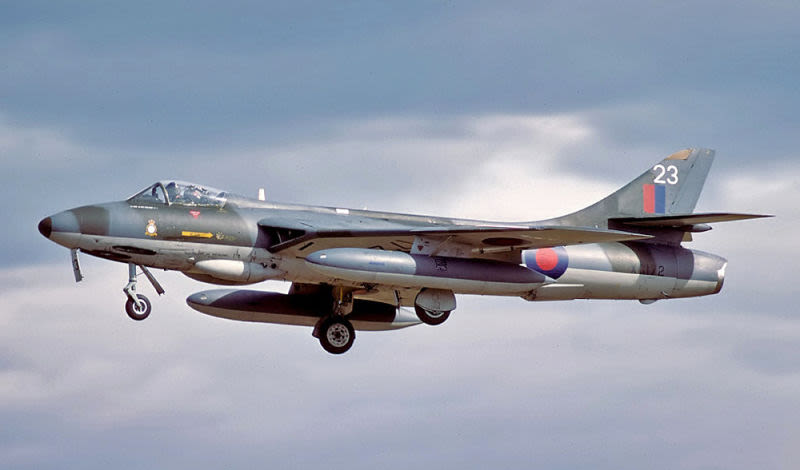 !!!CAPTION ERROR: MAY BE MULTI-LINE OR CONTAIN LINK!!!
!!!CAPTION ERROR: MAY BE MULTI-LINE OR CONTAIN LINK!!!
July 20, 1951 – The first flight of the Hawker Hunter. The history of aviation is a story of extraordinarily rapid development, but perhaps there was no greater sea change in flight than the introduction of the jet engine during the Second World War. This fundamental change in aviation power not only brought with it new realms of speed, it also brought about significant changes in airplane design, particularly the use of swept wings. Though the jet engine was a product of technological advances before and during the war, the idea of sweeping the wings dates back to the earliest days of aviation, and significant theoretical work was done in the 1930s by !!!error: Indecipherable SUB-paragraph formatting!!! . Despite this, the first operational jet-powered aircraft were all straight-wing designs, essentially piston aircraft given a new power plant.
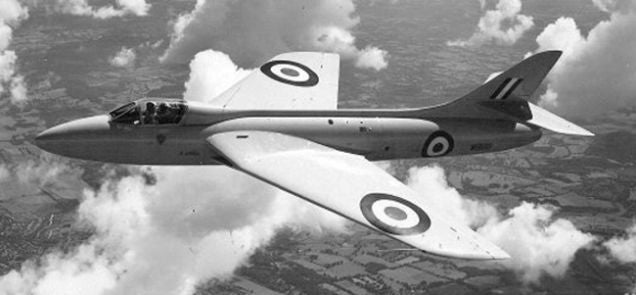
Hawker Hunter prototype. (Author unknown)
The British introduced the first Allies’ first (and only) operational jet of WWII with the !!!error: Indecipherable SUB-paragraph formatting!!! in 1944, and Hawker followed in 1947 with the !!!error: Indecipherable SUB-paragraph formatting!!! , which was essentially a jet-powered development of earlier piston-powered designs. In 1946, the British Air Ministry issued specification 38/46 which called for an investigation into the flight characteristics of a swept wing aircraft at low speeds. Hakwer responded with a swept-wing variant of the Sea Hawk, the !!!error: Indecipherable SUB-paragraph formatting!!! , which had been designed by Hawker’s chief designer !!!error: Indecipherable SUB-paragraph formatting!!! . Only two were built, but development continued with the !!!error: Indecipherable SUB-paragraph formatting!!! , and by now the characteristic and classic lines of the Hunter were beginning to emerge. Later that year, the British Air Ministry issued a specification for a new daytime, jet-powered interceptor to be powered by the !!!error: Indecipherable SUB-paragraph formatting!!! turbojet, a more compact and more powerful engine that provided as much power as the two combined !!!error: Indecipherable SUB-paragraph formatting!!! engines used on the Meteor. Hawker responded to the specification with the P.1067, a graceful, swept-wing design with a nose air intake, but Camm moved the intakes to the wing roots to allow for the installation of a nose-mounted radar.
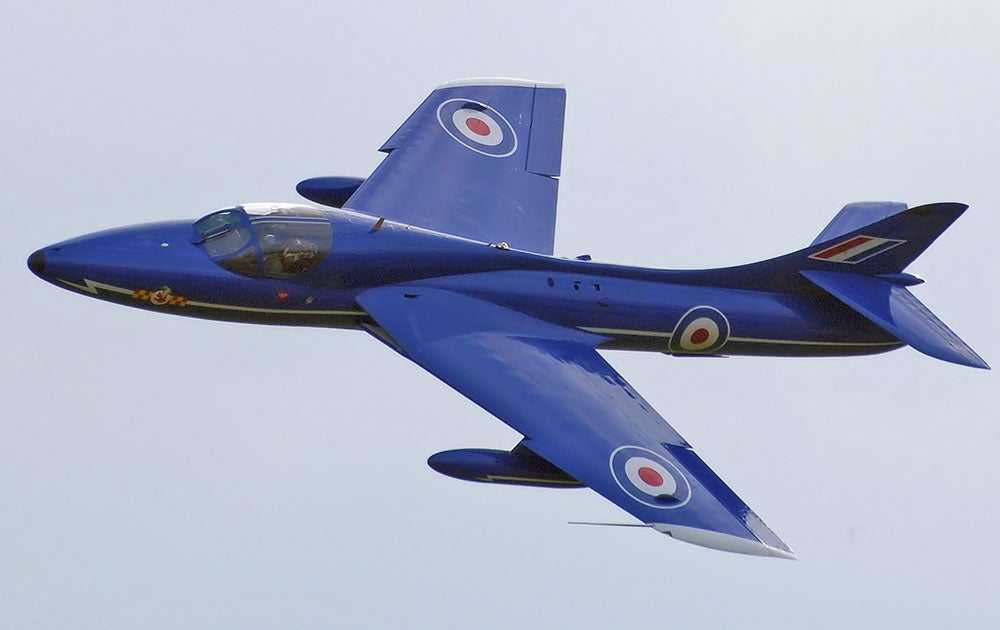 !!!CAPTION ERROR: MAY BE MULTI-LINE OR CONTAIN LINK!!!
!!!CAPTION ERROR: MAY BE MULTI-LINE OR CONTAIN LINK!!!
Two prototypes were built, and what was now known as the Hawker Hunter was ordered into production in 1950, the first jet-powered aircraft by Hawker to enter service with the RAF and the first British fighter with truly !!!error: Indecipherable SUB-paragraph formatting!!! performance. Hawker was competing with the !!!error: Indecipherable SUB-paragraph formatting!!! , an aircraft of similar design, but the Hunter proved to have significantly better performance, and was the first RAF aircraft capable of keeping pace with the !!!error: Indecipherable SUB-paragraph formatting!!! bomber. The Hunter was armed with four 30mm !!!error: Indecipherable SUB-paragraph formatting!!! , could carry 7,400 pounds or ordnance on external hardpoints, and had a top speed of Mach 0.94. It entered service with the RAF in July 1954, replacing the Meteor, the !!!error: Indecipherable SUB-paragraph formatting!!! and the !!!error: Indecipherable SUB-paragraph formatting!!! , and saw its first action escorting Canberra bombers during the !!!error: Indecipherable SUB-paragraph formatting!!! in 1956. The Hunter also proved popular with flight demonstration squadrons such as the !!!error: Indecipherable SUB-paragraph formatting!!! and the RAF’s !!!error: Indecipherable SUB-paragraph formatting!!! , which set a world record by performing a loop with 22 Hunters in formation. With the introduction of the supersonic !!!error: Indecipherable SUB-paragraph formatting!!! in 1959, the Hunter’s role changed from interceptor to ground attack and reconnaissance. Nearly 2,000 Hunters were produced, and roughly half of those were sold to 21 export customers around the world. The Hunter served the RAF for over 30 years, and some were flying for international customers as late as 1996. A number of the graceful fighters can still be seen flying the air show circuit in the hands of private collectors.
!!! UNKNOWN CONTENT TYPE !!!
Short Takeoff
!!! UNKNOWN CONTENT TYPE !!!

(US Air Force)
July 18, 2002 – The first flight of the Boeing YAL-1,
a modified
!!!error: Indecipherable SUB-paragraph formatting!!!
that was armed with a megawatt-class
!!!error: Indecipherable SUB-paragraph formatting!!!
(COIL) test its effectiveness as defense against tactical ballistic missiles. The program to fit a flying laser was initiated in 1996, with the laser, built by Northrop Grumman, housed in a turret constructed by Lockheed Martin. In 2007, the system was test-fired at an airborne target for the first time, with a second successful test in 2010, then a third which destroyed two test missiles. The program was canceled in 2011, and the YAL-1 was flown to
!!!error: Indecipherable SUB-paragraph formatting!!!
in Arizona where it was put in storage before being scrapped in 2014.
!!! UNKNOWN CONTENT TYPE !!!
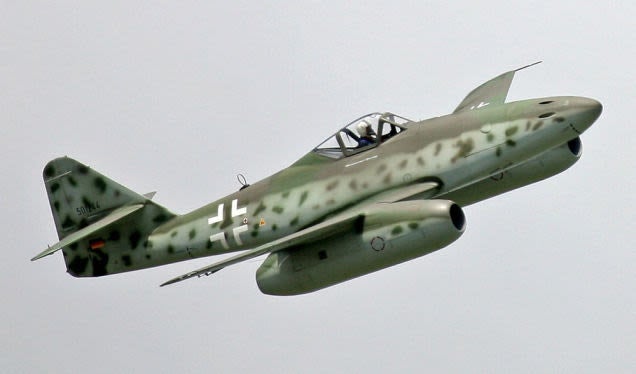 !!!CAPTION ERROR: MAY BE MULTI-LINE OR CONTAIN LINK!!!
!!!CAPTION ERROR: MAY BE MULTI-LINE OR CONTAIN LINK!!!
July 18, 1942 – The first flight of the Messerschmitt Me 262 under jet power.
Though the maiden flight of the Me 262, nicknamed
Schwalbe
(Swallow), had taken place more than a year earlier, delays in development of the
!!!error: Indecipherable SUB-paragraph formatting!!!
axial-flow turbojets meant that the 262's first flight was made using a single
!!!error: Indecipherable SUB-paragraph formatting!!!
piston engine mounted in the nose. The jet-powered Me 262 entered service in July 1942 as the world’s first operational jet fighter, and 262 pilots claimed 542 victories over Allied aircraft by the war’s end. However, difficulties with reliability of the early jet engines, and Allied attacks on Me 262 fuel supplies, hampered the operational capability of the jet fighter, and its impact on the war was ultimately negligible.
!!! UNKNOWN CONTENT TYPE !!!
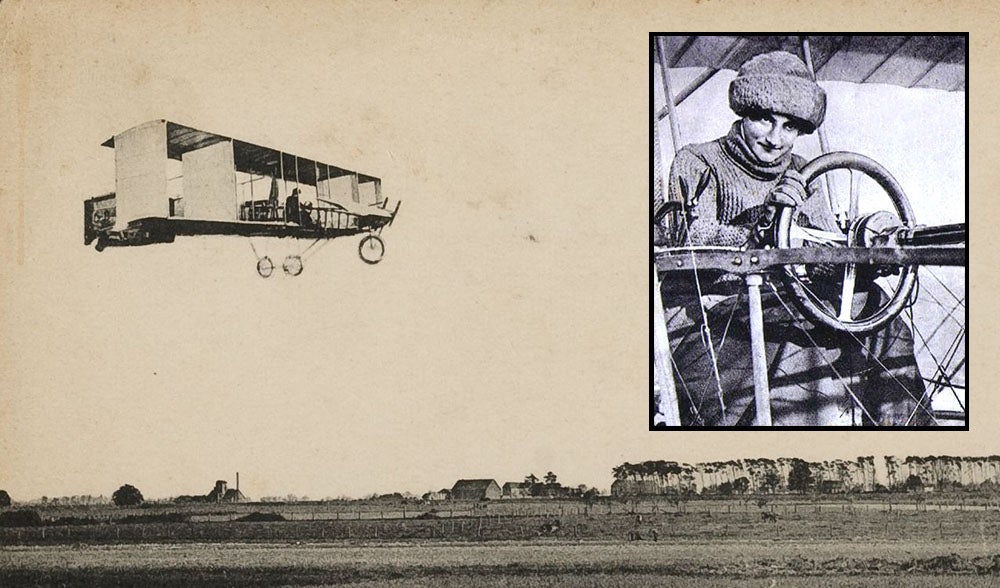
(US Library of Congress)
July 18, 1919 – The death of Raymond de Laroche, the first woman in the world to receive a pilot license. De Laroche (née Deroche) was born in Paris on August 22, 1882 into a working class family, and developed an affinity for cars and motorcycles while also working as an actress. In 1909 she convinced French aviation pioneer !!!error: Indecipherable SUB-paragraph formatting!!! to teach her to fly, and her first flight, and possibly the first by any woman pilot, was necessarily a solo flight since the Voisin aircraft had only one seat. De Laroche received her pilot license on March 8, 1910 and began taking part in aviation expositions as far away as Budapest and Egypt. In 1910 she was almost killed in a crash at Reims, but recovered and returned to flying. In 1913 she won the !!!error: Indecipherable SUB-paragraph formatting!!! for a flight of over four hours, and set two altitude records in 1919. While working to become the world’s first female test pilot, de Laroche was killed, along with her copilot, in the crash of an experimental aircraft
!!! UNKNOWN CONTENT TYPE !!!
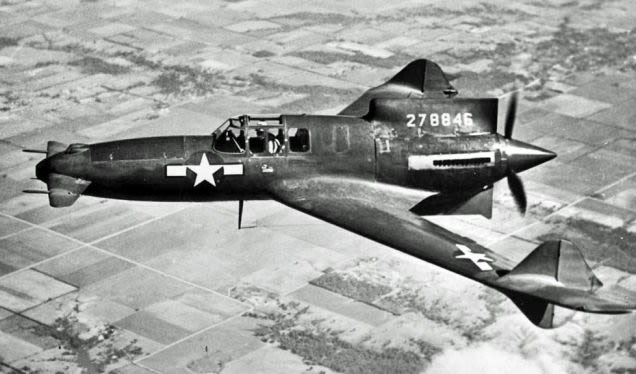
(US Air Force)
July 19, 1943 – The first flight of the Curtiss-Wright XP-55 Ascender. Fearing that American aircraft development was stagnating, the US Army Air Corps hoped to encourage innovative aircraft designs by issuing Request for Data R-40C in 1940. In response, the !!!error: Indecipherable SUB-paragraph formatting!!! proposed the XP-55 Ascender, a swept wing monoplane with a pusher propeller and a forward canard. Three prototypes were built, but testing showed that the airplane displayed poor stall characteristics, and the first prototype was lost to a crash. The third prototype of the Ascender (known derogatorily as the “ass ender”) saw further improvements to the wing, but this prototype was also lost to a crash that killed the pilot and as many as four civilians on the ground. Ultimately, the Ascender’s performance was found to be inferior to conventional fighters, and advances in jet fighters led to the XP-55’s cancellation.
!!! UNKNOWN CONTENT TYPE !!!
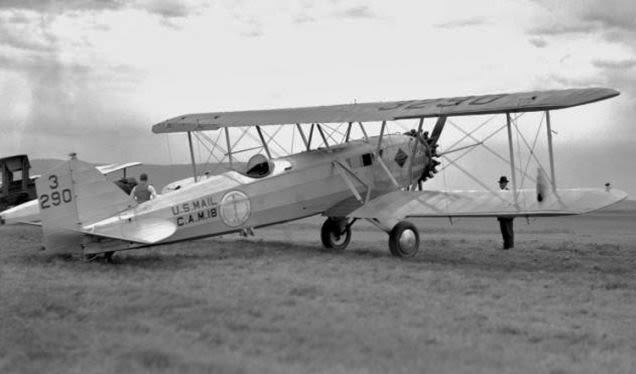
(Author unknown)
July 20, 1925 – The first flight of the Boeing Model 40, a mailplane developed as part of a requirement by the US Post Office to replace the !!!error: Indecipherable SUB-paragraph formatting!!! . After the Model 40 lost the airmail contract to the !!!error: Indecipherable SUB-paragraph formatting!!! , Boeing revised the design to make use of the !!!error: Indecipherable SUB-paragraph formatting!!! radial engine, which weighed less than the original !!!error: Indecipherable SUB-paragraph formatting!!! V-12 engine that had been stipulated by the Post Office. Boeing also strengthened and lengthened the fuselage to accommodate two passengers, with subsequent models having room four passengers. Thus, the Model 40 became the first passenger airplane to enter production for Boeing and, in 1927, Boeing Air Transport, the precursor to !!!error: Indecipherable SUB-paragraph formatting!!! , began operations between San Francisco and Chicago. Boeing produced 80 Model 40s, and one remains airworthy today.
!!! UNKNOWN CONTENT TYPE !!!
Connecting Flights
!!! UNKNOWN CONTENT TYPE !!!
!!! UNKNOWN CONTENT TYPE !!!
!!! UNKNOWN CONTENT TYPE !!!
!!! UNKNOWN CONTENT TYPE !!!
!!! UNKNOWN CONTENT TYPE !!!
!!! UNKNOWN CONTENT TYPE !!!
If you enjoy these Aviation History posts, please let me know in the comments. And if you missed any of the past articles, you can find them all at
!!!error: Indecipherable SUB-paragraph formatting!!!
. You can also find more stories about aviation, aviators and airplane oddities at
!!!error: Indecipherable SUB-paragraph formatting!!!
.
!!! UNKNOWN CONTENT TYPE !!!